Related Research Articles

Benue–Congo is a major branch of the Volta-Congo languages which covers most of Sub-Saharan Africa.

Southern Bantoid is a branch of the Bantoid language family. It consists of the Bantu languages along with several small branches and isolates of eastern Nigeria and west-central Cameroon. Since the Bantu languages are spoken across most of Sub-Saharan Africa, Southern Bantoid comprises 643 languages as counted by Ethnologue, though many of these are mutually intelligible.

Bantoid is a major branch of the Benue–Congo language family. It consists of the Northern Bantoid languages and the Southern Bantoid languages, a division which also includes the Bantu languages that constitute the overwhelming majority and to which Bantoid is named after.
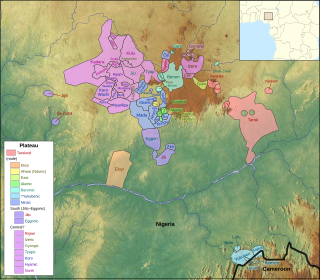
The forty or so Plateau languages are a tentative group of Benue–Congo languages spoken by 15 million people on the Jos Plateau, Southern Kaduna, Nasarawa State and in adjacent areas in central Nigeria.

The Beboid languages are any of several groups of languages spoken principally in southwest Cameroon, although two languages are spoken over the border in Nigeria. They are probably not most closely related to each other. The Eastern Beboid languages may be most closely related to the Tivoid and Momo groups, though some of the geographical Western Beboid grouping may be closer to Ekoid and Bantu.
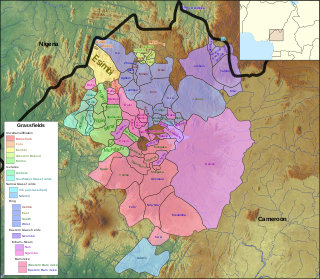
The Grassfields languages are a branch of the Southern Bantoid languages spoken in the Western High Plateau of Cameroon and some parts of Taraba state, Nigeria. Better known Grassfields languages include the Eastern Grassfields languages Bamun, Yamba and the Ring language, Kom, Nso, Oku, Bali, Bafut. Almost all of these languages are closely related, sharing approximately half of their vocabulary.
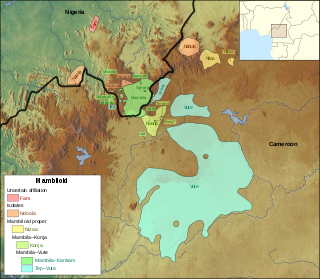
The twelve Mambiloid languages are languages spoken by the Mambila and related peoples mostly in eastern Nigeria and in Cameroon. In Nigeria the largest group is Mambila. In Cameroon the largest group is Vute.
Ukaan is a poorly described Niger–Congo language or dialect cluster of uncertain affiliation. Roger Blench suspects, based on wordlists, that it might be closest to the (East) Benue–Congo languages. Blench (2012) states that "noun-classes and concord make it look Benue-Congo, but evidence is weak."
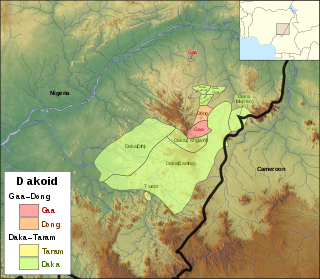
The Dakoid languages are a branch of the Northern Bantoid languages spoken in Taraba and Adamawa states of eastern Nigeria.
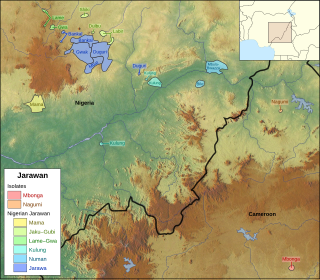
Jarawan is a group of languages spoken mostly in Bauchi State, Nigeria, with some also scattered in Plateau State, Taraba State, and Adamawa State in the same country. Two related languages formerly spoken in Cameroon are now extinct but are believed to have belonged to the group. This connection between Nigerian and Cameroonian Jarawan is attributed to Thomas (1925). Whether Jarawan languages are best classified alongside other Bantu languages or among non-Bantu Bantoid languages is a matter of ongoing debate. A number of descriptions and classifications in the early 20th century suggest that they be may historically related to Bantu languages but not necessarily Bantu themselves. Other perspectives based on lexicostatistic modeling and other phylogenetic techniques for language comparison argue instead that Jarawan languages are properly classified alongside Zone A Bantu languages (A31-A40-A60). For classifications based on these more recent studies, see for example Blench (2006), Piron (1997), and Grollemund (2012).

The Bendi languages are a small group of languages spoken in Cross River State, southeastern Nigeria. Bokyi is one of the Bendi languages having some speakers in Cameroon. Once counted among the Cross River languages, they may be a branch of Southern Bantoid, with observed similarities especially with the Ekoid languages.
Tikar is a Northern Bantoid, semi-Bantu language that is spoken in Cameroon by the Tikar people, as well as by the Bedzan Pygmies, who speak their own dialect of the language. A recent hypothesis by Roger Blench suggests that the Tikar language could be a divergent language in the Niger-Congo language family with an uncertain origin.
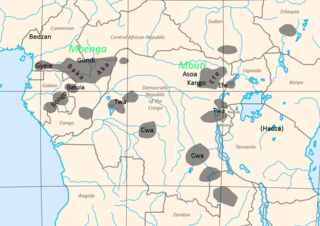
The Congo Pygmies are those "forest people" who have, or recently had, a hunter-gatherer economy and a simple, non-hierarchical societal structure based on bands, are of short stature, have a deep cultural and religious affinity with the Congo forest and live in a generally subservient relationship with agricultural "patrons", with which they trade forest products such as meat and honey for agricultural and iron products.
Daka is one of two languages spoken by the Chamba people in Nigeria, the other being Chamba Leko.
Toro, also known as Turkwam, is a Plateau language of Nigeria. It has lost the nominal affix system characteristic of the Niger–Congo family.
The Jagham language, Ejagham, also known as Ekoi, is an Ekoid language of Nigeria and Cameroon spoken by the Ekoi people. The E- in Ejagham represents the class prefix for "language", analogous to the Bantu ki- in KiSwahili
Dong, or Donga, is a poorly documented language in Nigeria. Though clearly Niger–Congo, it is difficult to classify; British linguist Roger Blench proposes that it is one of the Dakoid languages, the closest to Gaa.
Taram is language of Nigeria. It has traditionally been considered a dialect of Daka, but appears to be more divergent than that. It is poorly documented, only attested in a publication from 1931.
Northern Bantoid is a branch of the Bantoid languages. It consists of the Mambiloid, Dakoid, and Tikar languages of eastern Nigeria and west-central Cameroon.
Kulung (Wurkum) is a minor West Chadic language of Karim Lamido LGA, Taraba State, Nigeria that was recently discovered by Roger Blench. The language is not reported in Ethnologue or Glottolog. Blench (2019) gives a rough estimate of about 2,000 speakers.
References
- ↑ Gaa at Ethnologue (18th ed., 2015) (subscription required)